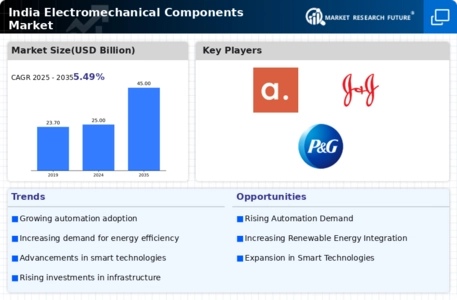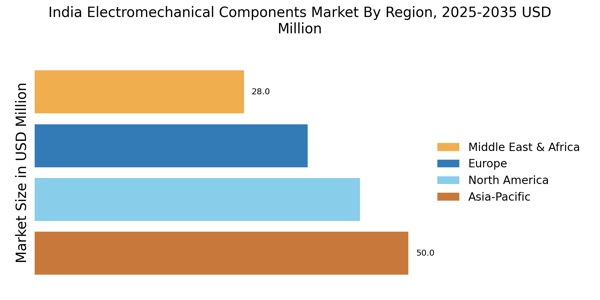Growth in Renewable Energy Sector
The expansion of the renewable energy sector in India serves as a significant catalyst for the India Electromechanical Components Market. With the government's commitment to achieving 175 GW of renewable energy capacity by 2022, and further targets set for 2030, there is a heightened demand for electromechanical components used in solar panels, wind turbines, and energy storage systems. This growth is indicative of a broader shift towards sustainable energy solutions, which require advanced electromechanical systems for efficiency and reliability. The India Electromechanical Components Market is poised to benefit from this trend, as manufacturers adapt to the evolving needs of the renewable energy landscape, potentially leading to innovations in component design and functionality.
Government Initiatives and Policies
Government initiatives aimed at boosting the manufacturing sector in India are significantly influencing the India Electromechanical Components Market. Programs such as 'Make in India' and 'Atmanirbhar Bharat' are designed to promote domestic manufacturing and reduce reliance on imports. These initiatives encourage local production of electromechanical components, thereby enhancing the competitiveness of Indian manufacturers. The government's focus on infrastructure development, including smart cities and transportation projects, further drives the demand for electromechanical components. As a result, the India Electromechanical Components Market is likely to experience growth, supported by favorable policies and increased investment in manufacturing capabilities.
Emerging Trends in Automotive Sector
The automotive sector in India is undergoing a transformation, with a growing emphasis on electric vehicles (EVs) and advanced automotive technologies. This shift is a key driver for the India Electromechanical Components Market, as EVs require specialized electromechanical components for battery management systems, electric drivetrains, and charging infrastructure. The Indian government aims to have 30% of vehicles on the road be electric by 2030, which could significantly increase the demand for these components. Additionally, advancements in automotive safety and connectivity features further necessitate the integration of electromechanical systems. Thus, the India Electromechanical Components Market is positioned to benefit from the evolving automotive landscape, as manufacturers adapt to meet the needs of this dynamic sector.
Advancements in Industrial Automation
The ongoing advancements in industrial automation are reshaping the landscape of the India Electromechanical Components Market. As industries increasingly adopt automation technologies to enhance productivity and efficiency, the demand for electromechanical components such as relays, sensors, and actuators is expected to rise. The Indian manufacturing sector is projected to grow at a CAGR of 12% from 2020 to 2025, further fueling the need for sophisticated electromechanical solutions. This trend indicates a shift towards smart manufacturing, where electromechanical components play a crucial role in enabling automation and connectivity. Consequently, the India Electromechanical Components Market is likely to witness robust growth as companies invest in modernizing their operations.
Rising Demand for Consumer Electronics
The increasing demand for consumer electronics in India is a pivotal driver for the India Electromechanical Components Market. With a burgeoning middle class and rising disposable incomes, the consumption of electronic devices such as smartphones, laptops, and home appliances is on the rise. According to recent estimates, the consumer electronics market in India is projected to reach USD 400 billion by 2025. This surge in demand necessitates a corresponding increase in electromechanical components, which are essential for the functionality of these devices. As manufacturers strive to meet consumer expectations for quality and performance, the India Electromechanical Components Market is likely to experience substantial growth, driven by the need for innovative and reliable components.

















Leave a Comment